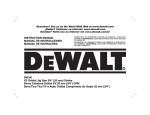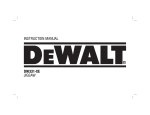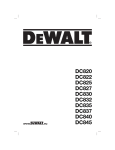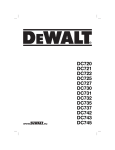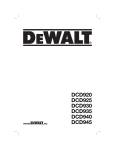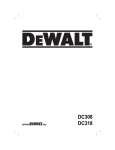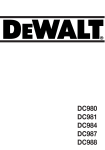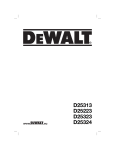Download DeWalt DC330 Technical data
Transcript
www. .eu DC330 3 24 4 11 2 1 12 5 10 9 8 6 7 12 13 15 14 A 1 16 12 16 12 B 8 7 6 4 C 2 D 10 18 19 20 8 17 E F1 18 19 21 17 23 5 22 F2 G 3 H 1 2 2 1 I 4 J K L 5 ENGLISH CORDLESS JIGSAW DC330 Congratulations! differ. This may significantly increase the exposure level over the total working period. You have chosen a DEWALT tool. Years of experience, thorough product development and innovation make DEWALT one of the most reliable partners for professional power tool users. An estimation of the level of exposure to vibration should also take into account the times when the tool is switched off or when it is running but not actually doing the job. This may significantly reduce the exposure level over the total working period. Technical Data Voltage Type Max. power output No-load speed Stroke length Cutting depth in: - wood - aluminum - steel Bevel angle adjustment (l/r) Weight (without battery pack) LPA (sound pressure) KPA (sound pressure uncertainty) LWA (sound power) KWA (sound power uncertainty) W min-1 mm DC330 18 1 400 0–3,000 26 mm mm mm ˚ 130 25 10 0–45 kg 2.4 dB(A) 87 dB(A) dB(A) dB(A) 3.0 98 3.0 VDC Vibration total values (triax vector sum) determined according to EN 60745: Vibration emission value ah = Uncertainty K = m/s² m/s² 11 2.6 The vibration emission level given in this information sheet has been measured in accordance with a standardised test given in EN 60745 and may be used to compare one tool with another. It may be used for a preliminary assessment of exposure. WARNING: The declared vibration emission level represents the main applications of the tool. However if the tool is used for different applications, with different accessories or poorly maintained, the vibration emission may Identify additional safety measures to protect the operator from the effects of vibration such as: maintain the tool and the accessories, keep the hands warm, organisation of work patterns. Battery pack Battery type Voltage Capacity Weight VDC Ah kg Charger Mains voltage Battery type VAC Approx. charging time min Weight kg Fuses: Europe U.K. & Ireland DE9096 NiCd 18 2.4 1.0 DE9503 NiMH 18 2.6 1.0 DE9116 230 NiCd/ NiMH 60 (2.0 Ah battery packs) 0.4 DE9130 DE9135 230 230 NiCd/ NiCd/NiMH/ NiMH Li-Ion 30 40 (2.0 Ah (2.0 Ah battery battery packs) packs) 0.52 0.52 230 V tools 230 V tools DE9180 Li-Ion 18 2.0 0.68 10 Amperes, mains 13 Amperes, in plugs Definitions: Safety Guidelines The definitions below describe the level of severity for each signal word. Please read the manual and pay attention to these symbols. DANGER: Indicates an imminently hazardous situation which, if not avoided, will result in death or serious injury. 33 EN GLI S H WARNING: Indicates a potentially hazardous situation which, if not avoided, could result in death or serious injury. CAUTION: Indicates a potentially hazardous situation which, if not avoided, may result in minor or moderate injury. NOTICE: Indicates a practice not related to personal injury which, if not avoided, may result in property damage. Denotes risk of electric shock. Denotes risk of fire. EC-Declaration of Conformity MACHINERY DIRECTIVE DC330 DEWALT declares that these products described under “technical data” are in compliance with: 98/37/EC (until Dec. 28, 2009), 2006/42/EC (from Dec. 29, 2009), EN 60745-1, EN 60745-2-11. These products also comply with Directive 2004/108/EC. For more information, please contact DEWALT at the following address or refer to the back of the manual. The undersigned is responsible for compilation of the technical file and makes this declaration on behalf of DEWALT. Horst Grossmann Vice President Engineering and Product Development DEWALT, Richard-Klinger-Straße 11, D-65510, Idstein, Germany 15.09.2009 34 WARNING: To reduce the risk of injury, read the instruction manual. General Power Tool Safety Warnings WARNING! Read all safety warnings and instructions Failure to follow the warnings and instructions may result in electric shock, fire and/or serious injury. SAVE ALL WARNINGS AND INSTRUCTIONS FOR FUTURE REFERENCE The term “power tool” in the warnings refers to your mains-operated (corded) power tool or batteryoperated (cordless) power tool. 1) WORK AREA SAFETY a) Keep work area clean and well lit. Cluttered or dark areas invite accidents. b) Do not operate power tools in explosive atmospheres, such as in the presence of flammable liquids, gases or dust. Power tools create sparks which may ignite the dust or fumes. c) Keep children and bystanders away while operating a power tool. Distractions can cause you to lose control. 2) ELECTRICAL SAFETY a) Power tool plugs must match the outlet. Never modify the plug in any way. Do not use any adapter plugs with earthed (grounded) power tools. Unmodified plugs and matching outlets will reduce risk of electric shock. b) Avoid body contact with earthed or grounded surfaces such as pipes, radiators, ranges and refrigerators. There is an increased risk of electric shock if your body is earthed or grounded. c) Do not expose power tools to rain or wet conditions. Water entering a power tool will increase the risk of electric shock. d) Do not abuse the cord. Never use the cord for carrying, pulling or unplugging the power tool. Keep cord away from heat, oil, sharp edges or moving parts. Damaged or entangled cords increase the risk of electric shock. e) When operating a power tool outdoors, use an extension cord suitable for outdoor use. Use of a cord suitable for outdoor use reduces the risk of electric shock. f) If operating a power tool in a damp location is unavoidable, use a residual current device (RCD) protected supply. Use of an RCD reduces the risk of electric shock. ENGLISH 3) PERSONAL SAFETY a) Stay alert, watch what you are doing and use common sense when operating a power tool. Do not use a power tool while you are tired or under the influence of drugs, alcohol or medication. A moment of inattention while operating power tools may result in serious personal injury. b) Use personal protective equipment. Always wear eye protection. Protective equipment such as dust mask, non-skid safety shoes, hard hat, or hearing protection used for appropriate conditions will reduce personal injuries. c) Prevent unintentional starting. Ensure the switch is in the off position before connecting to power source and/or battery pack, picking up or carrying the tool. Carrying power tools with your finger on the switch or energising power tools that have the switch on invites accidents. d) Remove any adjusting key or wrench before turning the power tool on. A wrench or a key left attached to a rotating part of the power tool may result in personal injury. e) Do not overreach. Keep proper footing and balance at all times. This enables better control of the power tool in unexpected situations. f) Dress properly. Do not wear loose clothing or jewellery. Keep your hair, clothing and gloves away from moving parts. Loose clothes, jewellery or long hair can be caught in moving parts. g) If devices are provided for the connection of dust extraction and collection facilities, ensure these are connected and properly used. Use of dust collection can reduce dust-related hazards. 4) POWER TOOL USE AND CARE a) Do not force the power tool. Use the correct power tool for your application. The correct power tool will do the job better and safer at the rate for which it was designed. b) Do not use the power tool if the switch does not turn it on and off. Any power tool that cannot be controlled with the switch is dangerous and must be repaired. c) Disconnect the plug from the power source and/or the battery pack from the power tool before making any adjustments, changing accessories, or d) e) f) g) storing power tools. Such preventive safety measures reduce the risk of starting the power tool accidentally. Store idle power tools out of the reach of children and do not allow persons unfamiliar with the power tool or these instructions to operate the power tool. Power tools are dangerous in the hands of untrained users. Maintain power tools. Check for misalignment or binding of moving parts, breakage of parts and any other condition that may affect the power tool’s operation. If damaged, have the power tool repaired before use. Many accidents are caused by poorly maintained power tools. Keep cutting tools sharp and clean. Properly maintained cutting tools with sharp cutting edges are less likely to bind and are easier to control. Use the power tool, accessories and tool bits etc., in accordance with these instructions taking into account the working conditions and the work to be performed. Use of the power tool for operations different from those intended could result in a hazardous situation. 5) BATTERY TOOL USE AND CARE a) Recharge only with the charger specified by the manufacturer. A charger that is suitable for one type of battery pack may create a risk of fire when used with another battery pack. b) Use power tools only with specifically designated battery packs. Use of any other battery packs may create a risk of injury and fire. c) When battery pack is not in use, keep it away from other metal objects like paper clips, coins, keys, nails, screws or other small metal objects that can make a connection from one terminal to another. Shorting the battery terminals together may cause burns or a fire. d) Under abusive conditions, liquid may be ejected from the battery, avoid contact. If contact accidentally occurs, flush with water. If liquid contacts eyes, additionally seek medical help. Liquid ejected from the battery may cause irritation or burns. 6) SERVICE a) Have your power tool serviced by a qualified repair person using only identical replacement parts. This will ensure that the safety of the power tool is maintained. 35 EN GLI S H Additional Safety Rules for Jigsaws • Hold power tool by insulated gripping surfaces when performing an operation where the cutting tool may contact hidden wiring or its own cord. Contact with a “live” wire will make exposed metal parts of the tool “live” and shock the operator. Markings on Tool The following pictograms are shown on the tool: Read instruction manual before use. Wear ear protection. • Use clamps or another practical way to secure and support the workpiece to a stable platform. Holding the work by hand or against your body leaves it unstable and may lead to loss of control. • When using saw blades specially designed for cutting wood, remove all nails and metal objects from the workpiece before starting work. • Wherever possible, use clamps and vices to fasten the workpiece securely. • Do not attempt to saw extremely small workpieces. • Do not bend too far forward. Make sure that you always stand firmly, particularly on scaffolding and ladders. • Always hold the saw with both hands. • For cutting curves and pockets, use an adapted saw blade. CHECKING AND CHANGING THE SAW BLADE • Only use saw blades conforming to the specifications contained in these operating instructions. • Only sharp saw blades in perfect working condition should be used; cracked or bent saw blades should be discarded and replaced at once. • Ensure that the saw blade is securely fixed. • The saw blade could be hot due to the work process. So when changing the blade make sure that it is chilled, cooled off or wear protective gloves when touching the blade. Residual Risks • In spite of the application of the relevant safety regulations and the implementation of safety devices, certain residual risks cannot be avoided. These are: – Impairment of hearing. – Risk of accidents caused by the uncovered parts of the moving saw blade. – Risk of injury when changing the blade. – Risk of dust inhalation from materials that when cut, can be harmful. 36 Wear eye protection. DATE CODE POSITION The Date Code, which also includes the year of manufacture, is printed into the housing surface that forms the mounting joint between tool and battery. Example: 2009 XX XX Year of Manufacture Important Safety Instructions for All Battery Chargers SAVE THESE INSTRUCTIONS: This manual contains important safety and operating instructions for the DE9116/DE9130/DE9135 battery chargers. • Before using charger, read all instructions and cautionary markings on charger, battery pack, and product using battery pack. DANGER: Electrocution hazard. 230 volts are present at charging terminals. Do not probe with conductive objects. Electric shock or electrocution may result. WARNING: Shock hazard. Do not allow any liquid to get inside charger. Electric shock may result. CAUTION: Burn hazard. To reduce the risk of injury, charge only DEWALT rechargeable batteries. Other types of batteries may burst causing personal injury and damage. CAUTION: Under certain conditions, with the charger plugged in to the power supply, the exposed charging contacts inside the charger can be shorted by foreign material. Foreign materials of a conductive nature such as, but not limited to, steel wool, aluminum foil, or any buildup of metallic particles should be kept away from charger cavities. Always unplug the charger from the power supply when ENGLISH there is no battery pack in the cavity. Unplug charger before attempting to clean. SAVE THESE INSTRUCTIONS Chargers • DO NOT attempt to charge the battery pack with any chargers other than the ones in this manual. The charger and battery pack are specifically designed to work together. The DE9116/DE9130 chargers accept DEWALT NiCd and NiMH battery packs ranging from 7.2 to 18 V. • These chargers are not intended for any uses other than charging DEWALT rechargeable batteries. Any other uses may result in risk of fire, electric shock or electrocution. These chargers require no adjustment and are designed to be as easy as possible to operate. • Do not expose charger to rain or snow. • Pull by plug rather than cord when disconnecting charger. This will reduce risk of damage to electric plug and cord. • Make sure that cord is located so that it will not be stepped on, tripped over, or otherwise subjected to damage or stress. • Do not use an extension cord unless it is absolutely necessary. Use of improper extension cord could result in risk of fire, electric shock, or electrocution. • Do not place any object on top of charger or place the charger on a soft surface that might block the ventilation slots and result in excessive internal heat. Place the charger in a position away from any heat source. The charger is ventilated through slots in the top and the bottom of the housing. • Do not operate charger with damaged cord or plug — have them replaced immediately. • Do not operate charger if it has received a sharp blow, been dropped, or otherwise damaged in any way. Take it to an authorized service center. • Do not disassemble charger; take it to an authorized service center when service or repair is required. Incorrect reassembly may result in a risk of electric shock, electrocution or fire. • Disconnect the charger from the outlet before attempting any cleaning. This will reduce the risk of electric shock. Removing the battery pack will not reduce this risk. • NEVER attempt to connect 2 chargers together. • The charger is designed to operate on standard 230V household electrical power. Do not attempt to use it on any other voltage. This does not apply to the vehicular charger. The DE9135 charger accepts 7.2–18 V NiCd, NiMH or Li-Ion batteries. Charging Procedure (Fig. A) DANGER: Electrocution hazard. 230 volts present at charging terminals. Do not probe with conductive objects. Danger of electric shock or electrocution. 1. Plug the charger (14) into an appropriate outlet before inserting battery pack. 2. Insert the battery pack into the charger. The red (charging) light will blink continuously indicating that the charging process has started. 3. The completion of charge will be indicated by the red light remaining ON continuously. The pack is fully charged and may be used at this time or left in the charger. NOTE: To ensure maximum performance and life of NiCd, NiMH and Li-Ion batteries, charge the battery for a minimum of 10 hours before first use. Charging Process Refer the table below for the state of charge of the battery pack. State of charge charging fully charged hot/cold pack delay replace battery pack problem – – – – – – ––––––––––– ––– – ––– – ••••••••••• •• •• •• •• Automatic Refresh The automatic refresh mode will equalise or balance the individual cells in the battery pack at its peak capacity. Battery packs should be refreshed weekly or whenever the pack no longer delivers the same amount of work. To refresh your battery pack, place the battery in the charger as usual. Leave the battery pack for at least 10 hours in the charger. 37 EN GLI S H Hot/Cold Pack Delay When the charger detects a battery that is too hot or too cold, it automatically starts a Hot/Cold Pack Delay, suspending charging until the battery has reached an appropriate temperature. The charger then automatically switches to the pack charging mode. This feature ensures maximum battery life. LI-ION BATTERY PACKS ONLY Li-Ion batteries are designed with an Electronic Protection System that will protect the battery against overloading, overheating or deep discharge. The tool will automatically turn off if the Electronic Protection System engages. If this occurs, place the Li-Ion battery on the charger until it is fully charged. Important Safety Instructions for All Battery Packs When ordering replacement battery packs, be sure to include catalog number and voltage. Consult the chart at the end of this manual for compatibility of chargers and battery packs. The battery pack is not fully charged out of the carton. Before using the battery pack and charger, read the safety instructions below. Then follow charging procedures outlined. READ ALL INSTRUCTIONS CAUTION: When not in use, place tool on its side on a stable surface where it will not cause a tripping or falling hazard. Some tools with large battery packs will stand upright on the battery pack but may be easily knocked over. SPECIFIC SAFETY INSTRUCTIONS FOR NICKEL CADMIUM (NiCd) OR NICKEL METAL HYDRIDE (NiMH) • Do not incinerate the battery pack even if it is severely damaged or is completely worn out. The battery pack can explode in a fire. • A small leakage of liquid from the battery pack cells may occur under extreme usage or temperature conditions. This does not indicate a failure. However, if the outer seal is broken: a. and the battery liquid gets on your skin, immediately wash with soap and water for several minutes. b. and the battery liquid gets into your eyes, flush them with clean water for a minimum of 10 minutes and seek immediate medical attention. (Medical note: The liquid is 25–35% solution of potassium hydroxide.) SPECIFIC SAFETY INSTRUCTIONS FOR LITHIUM ION (Li-Ion) • Do not charge or use battery in explosive atmospheres, such as in the presence of flammable liquids, gases or dust. Inserting or removing the battery from the charger may ignite the dust or fumes. • Do not incinerate the battery pack even if it is severely damaged or is completely worn out. The battery pack can explode in a fire. Toxic fumes and materials are created when lithium ion battery packs are burned. • Charge the battery packs only in DEWALT chargers. • If battery contents come into contact with the skin, immediately wash area with mild soap and water. If battery liquid gets into the eye, rinse water over the open eye for 15 minutes or until irritation ceases. If medical attention is needed, the battery electrolyte is composed of a mixture of liquid organic carbonates and lithium salts. • DO NOT splash or immerse in water or other liquids. • Do not store or use the tool and battery pack in locations where the temperature may reach or exceed 40˚ C (105° F) (such as outside sheds or metal buildings in summer). DANGER: Never attempt to open the battery pack for any reason. If battery pack case is cracked or damaged, do not insert into charger. Do not crush, drop or damage battery pack. Do not use a battery pack or charger that has received a sharp blow, been dropped, run over or damaged in any way (i.e., pierced with a nail, hit with a hammer, stepped on). Electric shock or electrocution may result. Damaged battery packs should be returned to service center for recycling. 38 • Contents of opened battery cells may cause respiratory irritation. Provide fresh air. If symptoms persists, seek medical attention. WARNING: Burn hazard. Battery liquid may be flammable if exposed to spark or flame. Battery Cap (fig. B) A protective battery cap is supplied to cover the contacts of a detached battery pack. Without the protective cap in place, loose metal objects could short circuit the contacts, causing a fire hazard and damaging the battery pack. ENGLISH 1. Take off the protective battery cap before placing the battery pack in the charger or tool. 2. Place the protective cap over the contacts immediately after removing the battery pack from the charger or tool. WARNING: Make sure the protective battery cap is in place before storing or carrying a detached battery pack. Battery Pack (fig. A) BATTERY TYPE The DC330 operate on 18 volt battery packs. Storage Recommendations 1. The best storage place is one that is cool and dry away from direct sunlight and excess heat or cold. For optimum battery performance and life, store battery packs at room temperature when not in use. NOTE: Li-Ion battery packs should be fully charged when stored. 2. Long storage will not harm the battery pack or charger. Under proper conditions, they can be stored for up to 5 years. Labels on Charger and Battery Pack In addition to the pictographs used in this manual, the labels on the charger and the battery pack show the following pictographs: Read instruction manual before use. Do not expose to water. Have defective cords replaced immediately. Charge only between 4 °C and 40 °C. Discard the battery pack with due care for the environment. Do not incinerate the battery pack NiMH, NiCd+ and Li-Ion. Charges NiMH and NiCd battery packs. Charges Li-Ion battery packs. See technical data for charging time. Package Contents 1 Cordless jigsaw 1 Saw blade 2 Battery packs, NiCd (DC330KA) 2 Battery packs, NiMH (DC330KB) 2 Battery packs, Li-Ion (DC330KL) 1 Charger (DC330KA/DC330KB/DC330KL) 1 Kitbox (DC330KA/DC330KB/DC330KL) 1 Instruction manual Battery charging 1 Exploded drawing Battery charged NOTE: Battery packs and chargers are not included with N-models. Battery defective • Check for damage to the tool, parts or accessories which may have occurred during transport. Hot/cold pack delay • Take the time to thoroughly read and understand this manual prior to operation. Do not probe with conductive objects. Do not charge damaged battery packs Use only with DEWALT battery packs, others may burst, causing personal injury and damage. Description (fig. A) WARNING: Never modify the power tool or any part of it. Damage or personal injury could result. 1 Variable speed switch 2 Safety lock 3 Sawdust blower control 4 Blade latch 39 EN GLI S H 5 Finger guard 6 Blade holder Follow the fitting instructions supplied with good quality plugs. Recommended fuse: 3 A. 7 Guide roller Using an Extension Cable 8 Shoe An extension cord should not be used unless absolutely necessary. Use an approved extension cable suitable for the power input of your charger (see technical data). The minimum conductor size is 1 mm2; the maximum length is 30 m. 9 Pendulum stroke selector 10 Shoe lever 11 Main Handle 12 Battery pack 13 Release buttons 14 Charger When using a cable reel, always unwind the cable completely. ASSEMBLY AND ADJUSTMENT 15 Charging indicator (red) WARNING: Prior to assembly and adjustment, always remove the battery pack. Always switch off the tool before inserting or removing the battery pack. INTENDED USE Your DC330 jig saw is designed for professional cutting of wood, steel, aluminium, plastic and ceramic material at various work sites (i.e., construction sites). DO NOT use under wet conditions or in presence of flammable liquids or gases. These heavy-duty jigsaws are professional power tools. WARNING: Use only DEWALT battery packs and chargers. Inserting and Removing the Battery Pack from the Tool (fig. A) 1. Insert the battery pack (12) into the grip until it clicks in place. DO NOT let children come into contact with the tool. Supervision is required when inexperienced operators use this tool. Electrical Safety The electric motor has been designed for one voltage only. Always check that the battery pack voltage corresponds to the voltage on the rating plate. Also make sure that the voltage of your charger corresponds to that of your mains. 2. To remove the battery pack, press the two battery release buttons (13) simultaneously and pull the pack out of the grip. Fitting and Removing a Saw Blade (fig. C) The tool-free blade exchange system ensures quick and easy changing of saw blades. • Open the blade holder (6) by fully retracting the blade latch (4). Your DEWALT charger is double insulated in accordance with EN 60335; therefore no earth wire is required. • Insert the saw blade into the blade holder (6) guiding the back of the blade into the groove of the guide roller (7). If the supply cord is damaged, it must be replaced by a specially prepared cord available through the DEWALT service organization. Mains Plug Replacement (U.K. & Ireland Only) If a new mains plug needs to be fitted: • Safely dispose of the old plug. • Connect the brown lead to the live terminal in the plug. • Release the blade latch (4). • To remove the saw blade, fully retract the blade latch and pull the blade out of the holder. SAW BLADES Blade type Fine-toothed cutting blade Coarse-toothed cutting blade Metal cutting blade • Connect the blue lead to the neutral terminal. WARNING: No connection is to be made to the earth terminal. Flush cutting blade1) 1) 40 Applications for smooth straight cuts for fast straight cuts for ferrous and non-ferrous metals for finishing off cuts up to a wall or edge. Not available in all countries. ENGLISH A wide variety of dedicated saw blades is available as an option. WARNING: Always select your saw blade with great care. Setting the Bevel Angle (fig. D) The adjustable shoe (8) allows cutting of LH and RH bevel angles up to 45°. The bevel scale has preset positions at 0°, 15°, 30° and 45°. • Release the shoe lever (10). Mounting and Removing the Anti-splinter Shoe Insert (fig. F1, F2) The anti-splinter shoe insert (18) which fits close to the saw blade reduces splintering of the workpiece. The insert can be mounted both into the shoe and the shoe cover. • Hold the insert (18) in the orientation as shown. • To mount the insert into the shoe (8): • Slide the shoe (8) toward the saw blade. – Slide the edges (19) into the grooves (20). • Tilt the shoe and set the desired bevel angle using the scale. – Slide the insert back into position against the shoe. • Tighten the shoe lever. • To mount the insert into the cover (17): Setting the Pendulum Stroke (fig. A) The adjustable pendulum stroke guarantees a perfect cutting stroke for different materials. • Slide the selector (9) to the desired position referring to the table below. The selector can be manipulated during operation. Pos. 3 2 Wood Fast cuts Thick workpieces Metal – – 1 Plywood Chipboard Thin workpieces Fine cuts Aluminium Non-ferrous Sheet metal 0 Plastics PVC Fibreglass Acrylic – – – Setting the Sawdust Blower (fig. A) The sawdust blower conducts an adjustable stream of air to the saw blade to keep the workpiece clear of sawdust during operation. • Set the sawdust blower using the lever (3). – Low For working with metals, when using coolants and lubricants and for use with dust extraction. – Intermediate For working with wood and similar materials in low speed. – High For working with wood and similar materials in high speed. – Slide the edges (19) behind the ribs (21). – Push the front end of the insert towards the cover. The insert snaps into place. • To remove the anti-splinter shoe insert do the above process in reverse order. Dust Extraction (fig. G) The dust extraction adaptor (22) in combination with the dust extraction shroud (23) helps extracting the dust from the workpiece surface, when connected to a suitable dust extraction system. • Place the dust extraction shroud (23) onto the finger guard (5) until it clicks in place. • Fit the dust extraction adaptor (22) to the tool as shown. • Connect the hose of a suitable dust extraction system to the adaptor. WARNING: Inhalation of dust developed when sawing wood presents a serious health hazard. Always connect a dust extraction system designed in compliance with the applicable directives regarding dust emission. Preferably wear a dust mask. WARNING: Do not use a dust extraction system without proper spark protection when sawing metal. Prior to Operation • Make sure your battery pack is (fully) charged. Mounting the Plastic Anti-scratch Shoe Cover (fig. E) The anti-scratch shoe cover (17) reduces damage to the surface of (sensitive) workpieces. • Click the cover onto the shoe as shown. 41 EN GLI S H OPERATION WARNING: Turn unit off and disconnect battery pack before installing and removing accessories, before adjusting or when making repairs. Lock the trigger switch when the tool is not in use and when storing the tool. WARNING: Always wear proper personal hearing protection. Under some conditions and duration of use, noise from this product may contribute to hearing loss. Instructions for Use Switching On and Off (fig. I) For safety reasons your tool is equipped with a safety lock. • To unlock the tool, release the safety lock (2). • To run the tool, press the variable speed switch (1). The pressure exerted on the variable speed switch determines the tool speed. • To stop the tool, release the switch. • To lock the tool in off position, activate the safety lock. WARNING: After using the tool for an extended period on low speed settings, run it for approx. 3 minutes on maximum no-load speed. WARNING: • Always observe the safety instructions and applicable regulations. • Make sure your workpiece is well secured. Remove nails, screws and other fasteners that may damage the blade. • Check that there is sufficient space for the blade underneath the workpiece. Do not cut materials that are thicker than the maximum cutting depth. • Use sharp saw blades only. Damaged or bent saw blades must be removed immediately. Sawing in Wood • If necessary, draw a cutting line. • Switch the tool on. • Hold the tool against the workpiece and follow the line. • For sawing parallel to the edge of your workpiece, install the parallel fence and guide your jigsaw along the workpiece a shown in figure J. Sawing in Wood Using a Pilot Hole • Do not use the tool for sawing pipes or tubes. • If necessary, draw a cutting line. • Never run your tool without a saw blade. • Drill a hole (ø min. 12 mm) and introduce the saw blade. • For optimal results, move the tool smoothly and constantly over the workpiece. Do not exert lateral pressure on the saw blade. Keep the shoe flat on the workpiece. When sawing curves, circles or other round shapes, push the tool gently forward. • Wait until the tool has come to a standstill before removing the saw blade from the workpiece. After sawing the blade may be very hot. Do not touch. Proper Hand Position (fig. A, H) WARNING: To reduce the risk of serious personal injury, ALWAYS use proper hand position as shown. WARNING: To reduce the risk of serious personal injury, ALWAYS hold securely in anticipation of a sudden reaction. Proper hand position requires one hand on the top handle (24), with the other hand on the main handle (11). 42 • Switch the tool on. • Follow the line. • For cutting perfectly round shapes, install the trammel bar and set it to the required radius (fig. K). Sawing up to a Projecting Edge (fig. L) • Using a conventional blade, cut up to the projected edge. • Finish off the cut using a flush cutting blade. Dust Extraction (fig. G) • When the tool is used indoor for extended periods of time, use a suitable dust extractor designed in compliance with the applicable Directives regarding dust emission. ENGLISH Sawing in Metal • Mount an appropriate saw blade. • Proceed as described above. CAUTION: Use a cooling lubricant (cutting oil) to prevent overheating of the saw blade or the workpiece. MAINTENANCE Your DEWALT power tool has been designed to operate over a long period of time with a minimum of maintenance. Continuous satisfactory operation depends upon proper tool care and regular cleaning. WARNING: To reduce the risk of serious personal injury, turn tool off and disconnect battery pack before making any adjustments or removing/installing attachments or accessories. An accidental start-up can cause injury. The charger is not serviceable. There are no serviceable parts inside the charger. CHARGER CLEANING INSTRUCTIONS WARNING: Shock hazard. Disconnect the charger from the AC outlet before cleaning. Dirt and grease may be removed from the exterior of the charger using a cloth or soft non-metallic brush. Do not use water or any cleaning solutions. Optional Accessories WARNING: Since accessories, other than those offered by DEWALT, have not been tested with this product, use of such accessories with this tool could be hazardous. To reduce the risk of injury, only DEWALT, recommended accessories should be used with this product. Consult your dealer for further information on the appropriate accessories. These include: – DE3241 Parallel guide – DE3242 Trammel bar – 581281-00 Dust extraction adapter Lubrication LUBRICATING THE GUIDE ROLLER (FIG. C) • Apply a drop of oil to the guide roller (7) at regular intervals to prevent jamming. – 581239-01 Dust extraction shroud – 402140-00 Anti-splinter shoe insert – 581268-00 Anti-scratch shoe cover The following replacement blades are available: – DT2209 Clean wood cutting blade – DT2213 Fast wood cutting blade – DT2160 Metal cutting blade Cleaning WARNING: Blow dirt and dust out of the main housing with dry air as often as dirt is seen collecting in and around the air vents. Wear approved eye protection and approved dust mask when performing this procedure. WARNING: Never use solvents or other harsh chemicals for cleaning the non-metallic parts of the tool. These chemicals may weaken the materials used in these parts. Use a cloth dampened only with water and mild soap. Never let any liquid get inside the tool; never immerse any part of the tool into a liquid. – DT2074 Flush cutting blade* *Not available in all countries Protecting the Environment Separate collection. This product must not be disposed of with normal household waste. Should you find one day that your DEWALT product needs replacement, or if it is of no further use to you, do not dispose of it with household waste. Make this product available for separate collection. Separate collection of used products and packaging allows materials to be recycled and used again. Re-use of recycled materials helps prevent environmental pollution and reduces the demand for raw materials. 43 EN GLI S H Local regulations may provide for separate collection of electrical products from the household, at municipal waste sites or by the retailer when you purchase a new product. DEWALT provides a facility for the collection and recycling of DEWALT products once they have reached the end of their working life. To take advantage of this service please return your product to any authorised repair agent who will collect them on our behalf. You can check the location of your nearest authorised repair agent by contacting your local DEWALT office at the address indicated in this manual. Alternatively, a list of authorised DEWALT repair agents and full details of our after-sales service and contacts are available on the Internet at: www.2helpU.com. Rechargeable Battery Pack This long life battery pack must be recharged when it fails to produce sufficient power on jobs which were easily done before. At the end of its technical life, discard it with due care for our environment: • Run the battery pack down completely, then remove it from the tool. • Li-Ion, NiCd and NiMH cells are recyclable. Take them to your dealer or a local recycling station. The collected battery packs will be recycled or disposed of properly. GUARANTEE DEWALT is confident of the quality of its products and offers an outstanding guarantee for professional users of the product. This guarantee statement is in addition to and in no way prejudices your contractual rights as a professional user or your statutory rights as a private non-professional user. The guarantee is valid within the territories of the Member States of the European Union and the European Free Trade Area. • 30 DAY NO RISK SATISFACTION GUARANTEE • If you are not completely satisfied with the performance of your DEWALT tool, simply return it within 30 days, complete with all original components, as purchased, to the point of purchase, for a full refund or exchange. The product must have been subject to fair wear and tear and proof of purchase must be produced. • ONE YEAR FREE SERVICE CONTRACT • If you need maintenance or service for your DEWALT tool, in the 12 months following purchase, it will be undertaken free of charge at an authorised DEWALT repair agent. Proof of purchase must be produced. Includes labour. Excludes accessories and spare parts unless failed under warranty. • ONE YEAR FULL WARRANTY • If your DEWALT product becomes defective due to faulty materials or workmanship within 12 months from the date of purchase, DEWALT guarantees to replace all defective parts free of charge or – at our discretion – replace the unit free of charge provided that: • The product has not been misused; • The product has been subject to fair wear and tear; • Repairs have not been attempted by unauthorised persons; • Proof of purchase is produced; • The product is returned complete with all original components. If you wish to make a claim, contact your seller or check the location of your nearest authorised DEWALT repair agent in the DEWALT catalogue or contact your DEWALT office at the address indicated in this manual. A list of authorised DEWALT repair agents and full details of our after-sales service is available on the Internet at: www.2helpU.com. 44 Belgique et Luxembourg België en Luxemburg Black & Decker - DEWALT Nieuwlandlaan 7, IZ Aarschot B156 B-3200 Aarschot Tel: +32 (0)015 - 15 47 9211 Fax: +32 (0)015 - 15 47 9210 www.dewalt.be Danmark DEWALT Sluseholmen 2-4 2450 København SV Tlf: 70201511 Fax: 70224910 www.dewalt.dk Deutschland DEWALT Richard-Klinger-Straße 65510 Idstein Tel: 06126-21-1 Fax: 06126-21-2770 www.dewalt.de Ελλάς Black & Decker (Hellas) S.A. Στράβωνος 7 & Βουλιαγμένης 159 Γλυφάδα 16674, Αθήνα Τηλ: (01) 8981-616 Φαξ: (01) 8983-570 Service: (01) 8982-630 España DEWALT Parque de Negocios “Mas Blau” Edificio Muntadas, c/Bergadá, 1, Of. A6 08820 El Prat de Llobregat (Barcelona) Tel: 934 797 400 Fax: 934 797 439 www.dewalt.es France DEWALT 5, allée des hêtres BP 30084, 69579 Limonest Cedex Tel: 04 72 20 39 20 Fax: 04 72 20 39 00 www.dewalt.fr Schweiz Suisse Svizzera DEWALT In der Luberzen 40 8902 Urdorf Tel: 01 - 730 67 47 Fax: 01 - 730 70 67 www.dewalt.ch Ireland DEWALT Calpe House Rock Hill Black Rock, Co. Dublin Tel: 00353-2781800 Fax: 00353-2781811 www.dewalt.ie Italia DEWALT Viale Elvezia 2 20052 Monza (Mi) Tel: 800-014353 Fax: 039-2387592 www.dewalt.it Nederlands Black & Decker - DEWALT Joulehof 12 4600 AB Bergen Op Zoom Tel: 0164 283000 Fax: 0164 283100 www.dewalt.nl Norge DEWALT Postboks 4814, Nydalen 0422 Oslo Tel: 22 90 99 00 Fax: 22 90 99 01 www.dewalt.no Österreich DEWALT Werkzeugevertriebs GmbH Erlaaerstraße 165, Postfach 320,1231 Wien Tel: 01 - 66116 - 0 Fax: 01 - 66116 - 14 www.dewalt.at Portugal DEWALT Rua Egas Moniz 173 João do Estoril, 2766-651 Estoril Tel: 214 66 75 00 Fax: 214 66 75 75 www.dewalt.pt Suomi DEWALT Oy Tekniikantie 12 02150 Espoo, Finland Puh: 010 400 430 Faksi: 0800 411 340 www.dewalt.fi DEWALT Oy Teknikvägen 12 02150 Esbo, Finland Tel: 010 400 430 Fax: 0800 411 340 www.dewalt.fi Sverige DEWALT Box 94 431 22 Mölndal Tel: 031 68 61 00 Fax: 031 68 60 08 www.dewalt.se Türkiye KALE Hırdavat ve Makina A.Ş. Defterdar Mah. Savaklar Cad. No:15 Edirnekapı / Eyüp / İSTANBUL 34050 TÜRKİYE Tel: 0212 533 52 55 Faks: 0212 533 10 05 www.dewalt.com.tr United Kingdom DEWALT 210 Bath Road Slough, Berks SL1 3YD Tel: 01753-56 70 55 Fax: 01753-57 21 12 www.dewalt.co.uk N044915 11/09



















